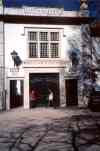|
|
|
The City of Aveiro is situated at the end of the estatuary of Aveiro. The estatuary is made up of mashes, lagoons, and canals. Like the neighboring villages of Ovar, Ilhavo, and Vago which are now land locked, Aveiro was once a seaport. However, in 1575 a violent storm closed the lagoon, the harbor silted up and the city, deprived of access to the ocean fell into decline. An effort by the Marquis of Pombal to rehabilitate it in the 18th century proved fruitless. as did other plans to breach the enclosure. Finally in 1808, a passage was opened from the lagoon to the sea.
|
|
|
Today, Aveiro still lives by its saltpans, grazing, rice paddies and land made fertile with the seaweed gathered from the bottom of the sea. It remains primarily a fishing town. However, industry in evolving including pottery by the famous firm of Vista Alegre, a paper mill, fish processing and canning, shipyards, and iron and steel works.
|
|
|
Source, Michelin Tourist Guide
|
|

Click to enlarge |
The Aveiro chapel is located in the basement and first floor of a large grouping of apartment and shopping buildings. The two windows shown in the picture brighten two classrooms with the chapel on the other side. Down stairs are more class rooms and the room where the portable font is stored.
|
|
|
The Aveiro train station is one of the most beautiful stations in northern Portugal. While not a large building, it is adorned with beautiful tile (azulejo) scenes from through out Portugal.
|

Click to enlarge |
|

Click to enlarge |
This is a picture of a traditional boat used in the lagoon of Aveiro. These boats are brightly colored. The long, and flat, some being 50 feet in length. The striking upturned and pointed bow and stern are typical of these boats from Aveiro.
|
|
|
This is another view of a boat from Aveiro. This view is of the boat floating in one of the canals that pass through the city of Aveiro.
|

Click to enlarge |
|

Click to enlarge |
Just south of Aveiro in the village of Ílhavo, is the factory of Vista Alegre. Vista Alegre has been manufacturing fine chinaware since 1824. They created chinaware for the Portuguese royalty in the last century. A museum on the factory premises displays products produced since the early 18th century. The china used in the mission home was made by Vista Alegre. Besides china, they create fine figurines.
|
|

